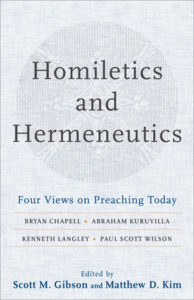
One of the most recent books – if not the most recent – to be published for preachers is Homiletics and Hermeneutics: Four Views on Preaching Today. Edited by Scott Gibson and Matthew Kim, the book became available in December 2018. What are the theological and hermeneutical underpinnings of our preaching? Do we preach Christ-centered or gospel-centered sermons? How does the flood narrative in Genesis 6 relate to the New Testament? This book will spark discussions about those questions and many others as preachers think through the different evangelical preaching traditions.
The book follows a simple format. Each practitioner presents his position followed by responses from the other three writers. Each writer interacts with four topics in advocating his position: 1) A biblical rationale, 2) A theological rationale, 3) A homiletical rationale and 4) An applicational rationale. There is a refreshing irenic spirit throughout the book as each writer debates the merits of each position with a heart of respect for each other.
FOUR VIEWS
Bryan Chapell presents his “Redemptive-Historic View.” Abraham Kuruvilla argues for his “Christiconic View.” Kenneth Langley advocates his “Theocentric View.” Paul Scott Wilson explains his “Law-Gospel View.” These are not the only views within evangelical Christianity, but they are four major views of preaching today. For this reason, Gibson and Kim have pulled these four preaching traditions together in one useful volume.
I expected to find significant differences, but I was struck first by a commonality more than the disparity. We hear much today about the importance of “Christ-centered” preaching as if every biblical text speaks of Jesus. All four writers agree that this approach is not hermeneutically accurate preaching. We do not have to force every text into a Jesus interpreted straitjacket! I appreciated the clarity of Bryan Chapell on the subject of “Christ-Centered” preaching. He writes, “Christ-centered preaching, rightly understood, does not seek to discover where Christ is mentioned in every biblical text, … but to show how each text manifests God’s grace in order to prepare and enable his people to embrace the hope provided by Christ” (7-8). The other three writers agree although they would question Chapell’s contention that the preacher should mention Christ in every sermon.
LAW-GOSPEL
I was least familiar with Paul Scott Wilson’s “Law-Gospel View,” since he comes from a church tradition very different from my baptistic background. For that reason alone, I found his section enlightening and interesting. I like Wilson’s purpose for preaching: “to proclaim the gospel, which I define as God’s saving actions recorded anywhere in the Bible that have their greatest clarity in Jesus Christ” (117). He goes on to argue that every sermon has two parts starting with law, which he calls “trouble,” and moving to gospel, which he calls “grace” always in that order (126). We must apply each part to our lives leading to what Wilson calls the four pages of a sermon (132). Every sermon should follow the same sequence according to Wilson. His approach, to me, is more formulaic than exegetical. As Langley points out, Wilson overlays a sermon schematic on the text instead of allowing the form of the text to control the sermon (155).
CHRISTICONIC
I am quite familiar with Kuruvilla’s “Christiconic View” having read several of his books and articles. He tends to be wordy and erudite but insightful especially in his analysis of pericopal theology. We should allow each pericope (unit of thought) to speak for itself. The purpose of preaching is to conform God’s people into the image (icon) of Christ. Every pericope in Scripture shows us a characteristic of Christ calling us to become like Christ. Hence, the Bible is Christological (59-60). However, is every pericope picturing a characteristic of Christ? Might we not end up imposing on the text an example we see but was not the intention of the original author? What about issues that are distinctly human, like sin and repentance which Jesus cannot exemplify?
REDEMPTIVE-HISTORIC
Bryan Chapell’s view is the most popular. I have used his text in my preaching classes. I like how he avoids a wooden Christ-centeredness despite the title of his book. He advocates a grace-centered model for preaching that emphasizes the redemption theme in Scripture above all other theological themes. I find in my preaching that some texts and sermons are not about redemption. Forcing the sermon to end in redemption feels arbitrary to me. All sermons take on a similar format, and we can sometimes ignore good exegesis in our quest to “make a beeline to the cross.” The Bible also teaches us about God’s nature as provider, sovereign, holy, sustainer and comforter. Some units of thought might focus on lesser, but still important, themes of Scripture. Why can’t we let these pericopes speak for themselves?
THEOCENTRIC
I fit most naturally into Kenneth Langley’s “Theocentric” model for preaching. I am pleased to be in good company with men like John Piper and Dale Davis, to name drop a little! Langley writes, “preaching should be God centered because God is God centered and wants us to be God centered in everything we do” (81). God is the “main actor” in Scripture, and even Jesus came preaching God centered messages so we should follow His example (87-88). Of course, God is the redeemer, but He is so much more than a redeemer. I like Langley’s emphasis on the “gospel of God” which Jesus preached (Mark 1:14). The gospel of God is a big gospel that encompasses so much more than justification by faith allowing us to preach the richness of all Scripture in its context. As Langley puts it, “a sermon should be big, because God is big!” (99)
I highly recommend this book to all preachers. You will be challenged to think through your methodology of preaching by excellent practitioners. I commend Gibson and Kim for putting this very useful book together for all of us who labor in the weekly work of the Word.


